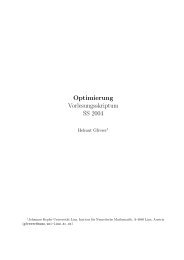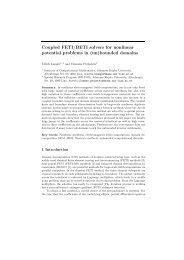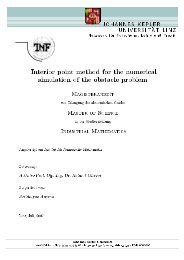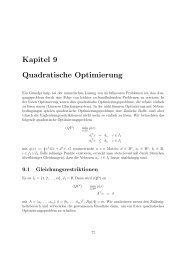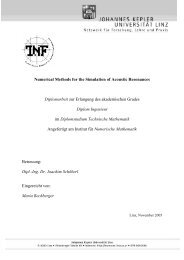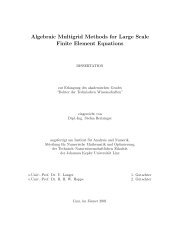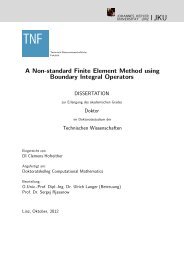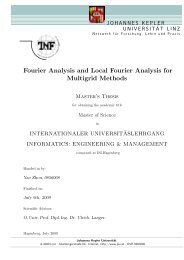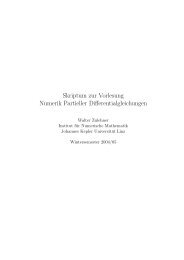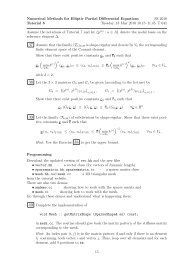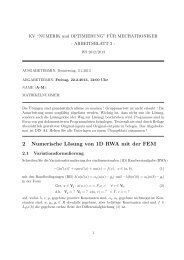Existence and Uniqueness of Eddy Current Problems in Bounded ...
Existence and Uniqueness of Eddy Current Problems in Bounded ...
Existence and Uniqueness of Eddy Current Problems in Bounded ...
Create successful ePaper yourself
Turn your PDF publications into a flip-book with our unique Google optimized e-Paper software.
4 MICHAEL KOLMBAUER<br />
I n<br />
n 2<br />
n 1<br />
2<br />
Σ⩵0<br />
air<br />
1<br />
Σ0<br />
conductor<br />
Figure 1. Unbounded exterior doma<strong>in</strong><br />
• semi-coercive, i.e. 〈A(u), u〉 ≥ c‖ curl u‖ 2 L 2(Ω)<br />
• bounded, i.e. 〈A(u), v〉 ≤ c‖u‖ H(curl,Ω) ‖v‖ H(curl,Ω)<br />
• hemicont<strong>in</strong>uous.<br />
Pro<strong>of</strong>. see [3, Lemma 2.6].<br />
For l<strong>in</strong>ear operators the whole analysis simplifies as the follow<strong>in</strong>g remark states.<br />
Remark 1. Let M be any l<strong>in</strong>ear operator. If M is semi-coercive, i.e. 〈M(w), w〉 ≥<br />
0, then M is also monotone.<br />
Hence the operator A result<strong>in</strong>g from the conduct<strong>in</strong>g part <strong>of</strong> our computational<br />
doma<strong>in</strong> naturally fulfills the requirements <strong>of</strong> Theorem 1 <strong>and</strong> Theorem 2. Therefore<br />
the idea <strong>of</strong> reduc<strong>in</strong>g the computational doma<strong>in</strong> to the conduct<strong>in</strong>g parts only, arises<br />
quite natural <strong>in</strong> this context.<br />
3. The eddy current problem <strong>in</strong> R 3<br />
Let Ω be R 3 <strong>and</strong> consist <strong>of</strong> two subdoma<strong>in</strong>s, Ω 1 <strong>and</strong> Ω 2 , with the follow<strong>in</strong>g properties.<br />
Ω 1 is Lipschitz polyhedron that is simply connected. Ω 2 is the complement<br />
<strong>of</strong> Ω 1 <strong>in</strong> R 3 , i.e R 3 \Ω 1 , <strong>and</strong> hence also simply connected. Furthermore we denote<br />
by Γ I the <strong>in</strong>terface <strong>of</strong> the two subdoma<strong>in</strong>s, i.e. Γ I = Ω 1 ∩ Ω 2 . By n we denote the<br />
exterior unit normal vector field <strong>of</strong> Ω 1 on Γ I , po<strong>in</strong>t<strong>in</strong>g from Ω 1 to Ω 2 (see Figure 1).<br />
Additionally to the partial differential equations <strong>in</strong> Ω 1 <strong>and</strong> Ω 2 , the solution has to<br />
be s<strong>in</strong>usoidal <strong>in</strong> Ω 2 . The system is completed by appropriate decay <strong>and</strong> <strong>in</strong>terface<br />
conditions <strong>and</strong> an <strong>in</strong>itial condition. Hence we deal with the follow<strong>in</strong>g problem:<br />
(1)<br />
⎧<br />
⎪⎨<br />
⎪⎩<br />
∂u<br />
σ 1 ∂t + curl (ν 1(|curl u|) curl u) = f 1 , <strong>in</strong> Ω 1 × (0, T )<br />
curl (curl u) = 0 <strong>in</strong> Ω 2 × (0, T )<br />
div u = 0 <strong>in</strong> Ω 2 × (0, T )<br />
u = O(|x| −1 ) for |x| → ∞<br />
curl u = O(|x| −1 ) for |x| → ∞<br />
u = u 0 on Ω 1 × {0}<br />
u 1 × n = u 2 × n on Γ I × (0, T )<br />
ν 1 (|curl u 1 |)curl u 1 × n = curl u 2 × n on Γ I × (0, T )<br />
Here u 1 <strong>and</strong> u 2 are the restrictions <strong>of</strong> u to Ω 1 <strong>and</strong> Ω 2 , i.e. u 1 = u| Ω1 <strong>and</strong> u 2 = u| Ω2 .<br />
Remark 2. Due to scal<strong>in</strong>g arguments, it can always be achieved that ν 2 = 1.<br />
(Otherwise ν 1 = ν 1 /ν 2 <strong>and</strong> σ 1 = σ 1 /ν 1 .)<br />
We show, that the degenerated parabolic problem on the whole doma<strong>in</strong> (1) can<br />
be reduced to an <strong>in</strong>itial value problem <strong>in</strong> the conduct<strong>in</strong>g region by us<strong>in</strong>g the tools<br />
<strong>of</strong> boundary <strong>in</strong>tegral operators. For the result<strong>in</strong>g parabolic equation, st<strong>and</strong>ard<br />
□



